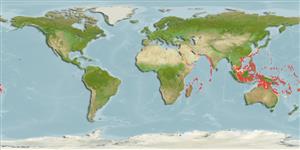Environment: milieu / climate zone / depth range / distribution range
Ökologie
seewasser riff-verbunden; tiefenbereich 8 - 55 m (Ref. 10671). Tropical
Indo-West Pacific: Mozambique to the Philippines.
Size / Gewicht / Alter
Maturity: Lm ? range ? - ? cm
Max length : 30.0 cm SL Männchen/unbestimmt; (Ref. 48637)
Rückenflossenstacheln (insgesamt): 5; Rückenflossenweichstrahlen (insgesamt): 28-30; Afterflossenstacheln 2; Afterflossenweichstrahlen: 28. Fresh specimens with yellow caudal fin and blackish peduncular plate; preserved specimens uniform grey in color and dark fins (pectorals pale). Oblique groove on side of snout below nostrils, its length about equal to length of naked area enclosing nostrils (Ref 9808).
Inhabits coastal to outer reef slopes, usually swimming along upper edges of drop-offs in small schools (Ref. 48637). Descends from the water column to the reef front to be cleaned by Labroides dimidiatus (Ref. 4974). Feeds on benthic algae (Ref. 3145). Forms aggregations, feeding on zooplankton well above the bottom over or in the immediate vicinity of reefs. Males exhibit rapid and striking changes in color pattern during courtship (Ref. 10671).
Life cycle and mating behavior
Geschlechtsreife | Fortpflanzung | Ablaichen | Eier | Fecundity | Larven
Randall, J.E., 1994. Unicornfishes of the subgenus Axinurus Perciformes: Acanthuridae: Naso), with description of a new species. Copeia 1994(1):116-124. (Ref. 10671)
IUCN Rote Liste Status (Ref. 130435)
Bedrohung für Menschen
Harmless
Nutzung durch Menschen
Mehr Information
NamenSynonymeMetabolismusRäuberÖkotoxikologieFortpflanzungGeschlechtsreifeAblaichenSpawning aggregationFecundityEierEientwicklung
ReferenzenAquakulturAquakultur ProfilZuchtlinienGenetikElectrophoresesVererbbarkeitKrankheitenVerarbeitungNutrientsMass conversion
PartnerBilderStamps, Coins Misc.LauteCiguateraGeschwindigkeitSchwimmstilKiemenoberflächeOtolithsGehirngrößeSehfähigkeit
Tools
Zusatzinformationen
Download XML
Internet Quellen
Estimates based on models
Preferred temperature (Ref.
123201): 25.2 - 28.9, mean 27.6 °C (based on 388 cells).
Phylogenetic diversity index (Ref.
82804): PD
50 = 0.5000 [Uniqueness, from 0.5 = low to 2.0 = high].
Bayesian length-weight: a=0.01862 (0.01050 - 0.03303), b=3.05 (2.90 - 3.20), in cm total length, based on LWR estimates for this species & Genus-body shape (Ref.
93245).
Trophic level (Ref.
69278): 2.6 ±0.29 se; based on food items.
Widerstandsfähigkeit (Ref.
120179): mittel, Verdopplung der Population dauert 1,4 - 4,4 Jahre. (Preliminary K or Fecundity.).
Fishing Vulnerability (Ref.
59153): Low to moderate vulnerability (27 of 100).
Nutrients (Ref.
124155): Calcium = 51.2 [31.1, 91.2] mg/100g; Iron = 0.606 [0.315, 1.012] mg/100g; Protein = 18.8 [17.7, 19.7] %; Omega3 = 0.145 [0.097, 0.256] g/100g; Selenium = 31.6 [17.9, 52.1] μg/100g; VitaminA = 74.4 [27.9, 200.8] μg/100g; Zinc = 1.5 [1.1, 2.1] mg/100g (wet weight);
